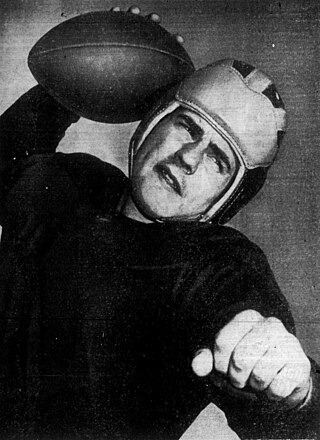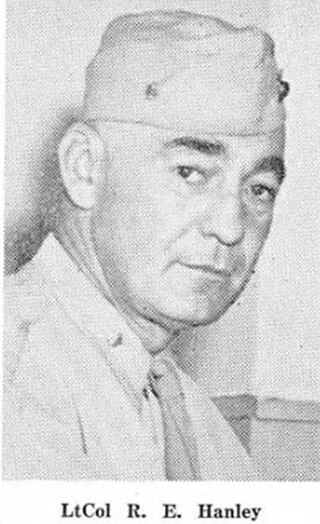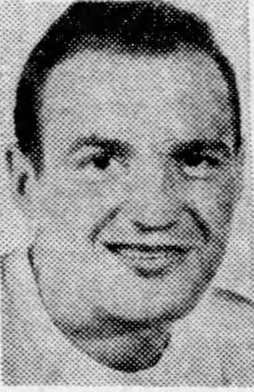Related Research Articles

Elroy Leon "Crazylegs" Hirsch was an American professional football player, sport executive and actor. He was inducted into the Pro Football Hall of Fame in 1967 and the College Football Hall of Fame in 1974. He was also named to the all-time All-Pro team selected in 1968 and to the National Football League (NFL) 1950s All-Decade Team.

Ernest Alonzo Nevers, sometimes known by the nickname "Big Dog", was an American football and baseball player and football coach. Widely regarded as one of the best football players in the first half of the 20th century, he played as a fullback and was a triple-threat man known for his talents in running, passing, and kicking. He was inducted with the inaugural classes of inductees into both the College Football Hall of Fame in 1951 and the Pro Football Hall of Fame in 1963. He was also named in 1969 to the NFL 1920s All-Decade Team.

Peter Louis Pihos was an American football player and coach.

Robert Stanton Waterfield was an American professional football player and coach who played in the National Football League (NFL) for eight seasons. He played quarterback for the UCLA Bruins and Cleveland/Los Angeles Rams and was inducted into the Pro Football Hall of Fame in 1965. His No. 7 jersey was retired by the Los Angeles Rams in 1952. He was also a motion picture actor and producer.

Charles Louis Trippi was an American professional football player for the Chicago Cardinals of the National Football League (NFL) from 1947 to 1955. Although primarily a halfback, his versatility allowed him to fill a multitude of roles over his career, including quarterback, safety, punter, and return specialist. A "quintuple-threat", Trippi was adept at running, catching, passing, punting, and defense.

Robert James "Hunchy" Hoernschemeyer was an American football player. A native of Cincinnati, he played college football as a halfback for the Indiana Hoosiers football in 1943 and 1944 and as a quarterback for the Navy Midshipmen football team in 1945. He led the NCAA in both total offense and passing yards during the 1943 season.
The 1947 Cleveland Browns season was the team's second in the All-America Football Conference (AAFC). Led by head coach Paul Brown, Cleveland finished with a 12–1–1 record, winning the Western division and the AAFC championship for the second straight year. As in 1946, quarterback Otto Graham led an offensive attack that featured fullback Marion Motley, ends Dante Lavelli, and Mac Speedie.

Robert Richard Chappuis was an American football player who played halfback and quarterback for the University of Michigan Wolverines in 1942, 1946, and 1947. His college years were interrupted by service in the U.S. Army Air Forces during World War II. Chappuis flew 21 missions as a radio operator and aerial gunner on B-25 bombers in the European Theater. His aircraft was shot down in February 1945 in the Lombardy region of Northern Italy. Chappuis parachuted from the plane before it crashed, and Italian partisans rescued him by hiding Chappuis and two other crew members for the final three months of the war.
The 1946 Miami Seahawks season was the inaugural one for the franchise and the first for the All-America Football Conference. Head coach Jack Meagher led the team to a 3–11 finish, fourth out of four teams in the Eastern Division.
The 1952 Detroit Lions season was the franchise's 23rd season in the National Football League. The Lions won their second National Football League (NFL) championship, having won their first championship 17 years earlier in 1935. The team's co-captains were halfback Bob Hoernschemeyer and defensive tackle John Prchlik, and defensive end Jim Doran was selected as the team's most valuable player. In their third year under head coach Buddy Parker, the 1952 Lions compiled a 9–3 record during the regular season, finished in a tie with the Los Angeles Rams for first place in the NFL's National Conference, defeated the Rams in a tiebreaker game, and defeated the Cleveland Browns, 17–7, in the 1952 NFL Championship Game at Municipal Stadium in Cleveland.

Richard Edgar Hanley was an American football player and coach. Hanley played quarterback at Washington State College from 1915 to 1917 and again in 1920. During his four years at Washington State, the them was 22–4–1, including a victory in the 1916 Rose Bowl over Brown. Hanley is notable for being one of the few players to have played in the Rose Bowl for two different teams. In 1918, he enlisted in the United States Marine Corps becoming a player and captain for the Marine Island Marines.
The 1946 San Francisco 49ers season was the inaugural season of the San Francisco 49ers and the first season of the All-America Football Conference. Led by head coach Buck Shaw, the team compiled a 9–5 record and finished second in the AAFC West Division. The 49ers also had the second best scoring offense in the AAFC.
The 1946 Ohio State Buckeyes football team was an American football team that represented Ohio State University in the 1946 Big Ten Conference football season. In Paul Bixler's only season as head coach, the Buckeyes compiled a 4–3–2 record and were outscored by a total of 170 to 166. The Buckeyes were ranked No. 12 in the AP Poll on November 4, 1946, but lost the final two games of their season against No. 9 Illinois and No. 8 Michigan. Right guard Warren Amling, a veterinary student, was elected as team captain.
The 1946 Michigan Wolverines football team represented the University of Michigan in the 1946 Big Nine Conference football season. In their ninth year under head coach was Fritz Crisler, the Wolverines compiled a 6–2–1 record, outscored opponents 233 to 73, and finished the season in second place in the Big Nine Conference and ranked No. 6 in the final 1946 AP poll. The team's two losses came against an undefeated Army team that was ranked No. 2 in the final AP poll and against an Illinois team that won the Big Nine championship and was ranked No. 5 in the final AP poll. Michigan won its last four games by a combined score of 162 to 19, starting a 25-game winning streak that continued for nearly three years until October 8, 1949. In the final game of the 1946 season, Michigan defeated Ohio State, 58–6, the Buckeyes' worst defeat since joining the conference in 1913.
The 1945 Michigan Wolverines football team represented the University of Michigan in the 1945 Big Ten Conference football season. In their eighth year under head coach was Fritz Crisler, the Wolverines compiled a 7–3 record and finished the season ranked #6 in the final Associated Press Poll. Quarterback Joe Ponsetto was the team captain, and center Harold Watts won the Most Valuable Player award and was selected as a first-team All-Big Ten Conference player.
The 1944 Michigan Wolverines football team represented the University of Michigan in the 1944 Big Ten Conference football season. Under seventh-year head coach Fritz Crisler, Michigan compiled a record of 8–2, outscored opponents 204 to 91, finished in second place in the Big Ten Conference, and was ranked #8 in the final AP Poll. The team opened the season with a victory over an Iowa-Pre-Flight team that won all of its remaining games and ended the season ranked #6 in the final AP Poll. The Wolverines then shut out four opponents: Marquette (14-0); Northwestern (27-0); Illinois (14-0); and Wisconsin (14-0). The team's two losses came against Indiana and an undefeated Ohio State team that was ranked #2 in the final AP Poll.
The 1946 Washington Huskies football team was an American football team that represented the University of Washington in the Pacific Coast Conference (PCC) during the 1946 college football season. In its fifth season under head coach Ralph "Pest" Welch, the team compiled a 5–4 record, finished in fourth place in the PCC, and outscored its opponents by a total of 144 to 140.
The 1945 Indiana Hoosiers football team was an American football team that represented the Indiana University Bloomington in the 1945 Big Ten Conference football season, compiled the only undefeated record and won the first Big Ten Conference championship in the program's history. In their 12th year under head coach Bo McMillin, the Hoosiers compiled a 9–0–1 record, outscored their opponents by a combined total of 279 to 56, and finished the season ranked #4 in the final AP Poll. The lone blemish on the team's record was a 7–7 tie with Northwestern in the second game of the season.
The 1946 AAFC season was the first season of the All-America Football Conference, a new professional league established to challenge the market dominance of the established National Football League. The league included eight teams, broken up into Eastern and Western divisions, which played a 14-game official schedule, culminating in a league championship game.

Robert Peter Jensen was an American football end.
References
- 1 2 "1946 Chicago Rockets Statistics and Players". Pro-Football-Reference.com. Sports Reference LLC. Retrieved March 4, 2020.
- ↑ "A New Twist: Rockets Now Self Coached". Chicago Tribune. September 27, 1946. p. II-1 – via Newspapers.com.
- ↑ "Boland Named Head Coach of Rocket Eleven". Chicago Tribune. October 30, 1946. p. III-1 – via Newspapers.com.
- ↑ "Jungmichael Named On All-AAFC Second". The Miami News. December 16, 1946. p. 4B – via Newspapers.com.
- ↑ "All-Star Pro Eleven Named". Baltimore Sun. January 5, 1947. p. Sports 2 – via Newspapers.com.
- ↑ "1946 Chicago Rockets (AAFC)". Pro Football Archives. Retrieved October 29, 2023.